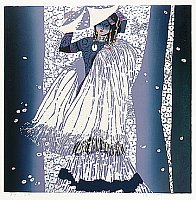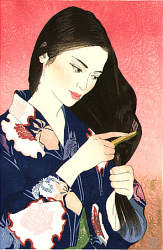Full History of The Abstract Art - Abstract Expressionism Movement and Expressions
The Abstract Expressionism Movement, also called the New York School was exclusively an American abstract art movement that mainstreamed in New York City in the period following the Second World War. This movement was significant in the sense that it was the earliest American movement to declare non-dependence on European styles and to get a sway all over the globe. It also enabled New York City to replace Paris as the art hub. Prior to its reference to American art, “abstract expressionism†was a term used in the Berlin periodical named ‘Der Sturm’, in 1919.
Arshile Gorky played an important role in inducing The Abstract Expressionism Movement. The abstract art works produced during the period of this movement are considered to be a combination of certain visual aspects of abstract European schools like Futurism, Synthetic Cubism and Bauhaus with the self-expression and emotional strength of German Expressionism. Though this abstract art was a mixture of a number of styles, its basic philosophy was to search and seek out answers for questions relating to human existence.
There are many similarities of style between abstract expressionism art and the work of Russian artists of the early 1900’s, the most prominent being Wassily Kandinsky. The abstract art from this period of the movement is often characterised by giving the impression of being produced in an act of artistic spontaneity. The work of pioneers of the movement such as Kandinsky, Kunz and later Rothko dealt with the expression of subjects including spirituality and the subconscious. However, meticulous planning and conscious thought was often involved in creating the many of the well known works of art which define this period of the expressionist movement.
In the 1930’s in North America, prior to the mainstream acceptance of abstract art, social realism art had been the prominent genre of art. Mexican social realists such as Diego Rivera and David Alfaro Siqueiros together with the Great Depression strongly influenced the acceptance and widespread popularity of this relatively short lived movement. Preceding the Second World War in the United States there arose a time of political sensitivity. Due this change in the political climate social protest made through art would no longer be tolerated. In American society an artistic vacuum had opened and the abstract expressionism movement arose into the mainstream, showcasing at major galleries in New York such as The Art of This Century Gallery. The abstract expressionist movement spread rapidly thorough the elite art community of the United States through its major artistic communities such including the San Francisco Bay area and California.
During the period of The Abstract Expressionism Movement, several artists started experimenting with shapes and colour. They broke away from what was considered to be artistic, conventional painting and painted complete canvases in blue, orange or other colours. Dripping, splattering and big brush strokes were characteristic features of Abstract Expressionist Art. The artists of this period preferred larger canvases positioned on the floor over canvases that were easel bound and moderate. The focus of abstract art within the expressionism movement was not the portrayal of objects but the portrayal of emotions.
In the broad sense, Abstract Expressionism was of two streams – Colour Field Painting and Action Painting. Colour field painting came up in the beginning of the 1960’s and involved using shape and colour to create religious serene paintings that were devoid of representative subject substance. The composition of colour field works were huge coloured areas with no forms or signs. Helen Frankenthaler, Mark Rothko and Ellsworth Kelly were some painters associated with this type of painting. Action Painting was a painting stream that arose prior to Colour Field Painting (between the 1940s and 1950s) and practiced by artists such as Jackson Pollock, Willem de Kooning and Franz Kline. The driving force for the works of these painters was often considered to be the painters’ soul and life energy.
Abstract Expressionist Art appeared to be defiant, idiosyncratic and radical, and to some, nihilistic. The movement weakened in the 1960s while other movements such as minimalism and pop art arose in opposition to it. Despite the movement losing importance, a good number of abstract expressionist painters continued following its characteristic painting fashion for many more years. In addition, this art movement profoundly influenced how some American artists of later generations used materials and colour in their Abstract Art.
Source
Article Author:
Innes Desborough
High quality and affordable artists blank canvases can be purchased form www.artistsblankcanvas.co.uk,
www.artistsstretchedcanvas.co.uk and www.artists-canvas.co.uk.






















































